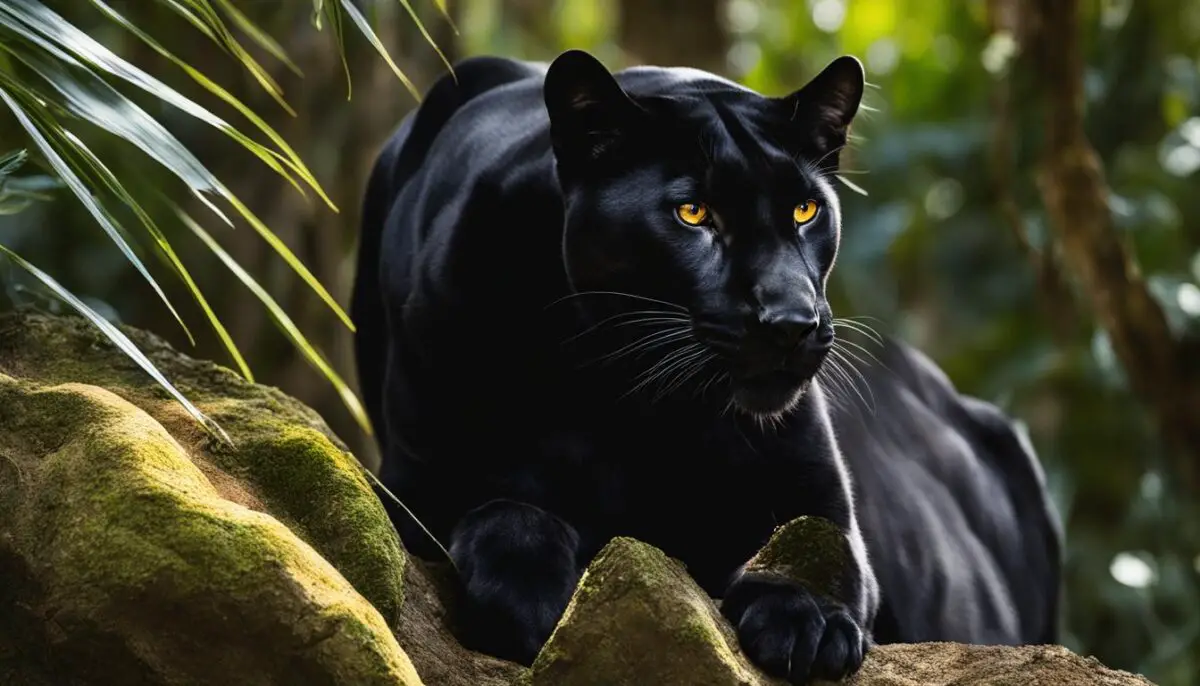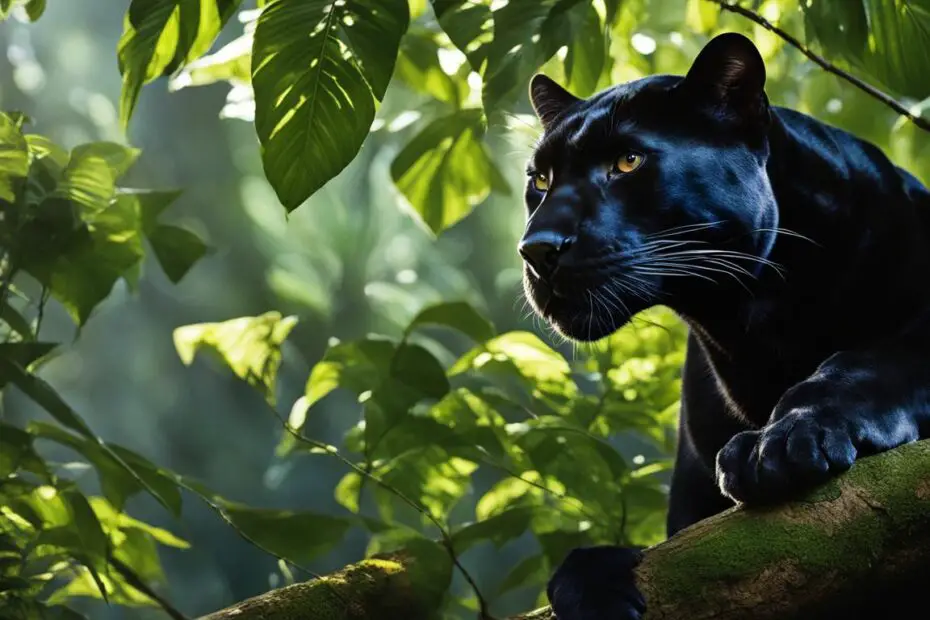Spotted black panthers have long been fascinating creatures that spark curiosity and intrigue. Are they a distinct species? Where can they be found? What are their unique characteristics? Let’s dive into the world of black panthers and uncover some of the mysteries surrounding these majestic creatures!
Key Takeaways:
- Spotted black panthers are not a separate species but a melanistic color variant of jaguars or leopards.
- They can be found in forests, swamplands, and grasslands across Asia, America, and Africa.
- Black panthers are solitary and nocturnal animals known for their agility and stealth while hunting.
- These magnificent creatures primarily feed on small to medium-sized herbivores.
- Due to human activities like deforestation and hunting, the population of black panthers has significantly declined, making them an endangered species.
Biology and Skin Color of Panthers
Panthers, often associated with their striking black coloration, are not a distinct species but rather melanistic variations of jaguars or leopards. This unique coloration is a result of genetic factors and is known as panther melanism. Let’s take a closer look at the biology and skin coloration of these fascinating creatures.
Genetics of Black Panthers
Black panthers can be either melanistic jaguars or melanistic leopards. The genetic basis for their dark pigmentation varies between the two species. Melanism in jaguars is caused by a dominant gene, while in leopards, it is a recessive gene. These genetic variations give rise to the magnificent black fur that differentiates panthers from their spotted counterparts.
Retained Markings and Camouflage
Contrary to popular belief, the black fur of panthers does not erase their markings. Instead, these markings can still be observed through their black coat. In regions with dense forests or low light levels, the black coloration provides panthers with a significant advantage in terms of camouflage. Their retained markings help them blend seamlessly into their environment, allowing them to become stealthy predators.
Immune System and Genetic Advantages
Recent studies have shown that black panthers possess genetic variations linked to their immune system, providing them with certain advantages. These variations may enhance their resistance to diseases and improve their overall fitness. Understanding these genetic traits is crucial for further research and conservation efforts aimed at protecting these iconic black panther species.

As we delve into the biology and skin coloration of panthers, it becomes clear that their majestic appearance is a product of genetic diversity and adaptations for survival. The next section will explore the habitats and hunting behaviors of these captivating creatures.
Habitat and Hunting Behavior of Panthers
Panthers, including black leopards and black jaguars, are versatile creatures that inhabit a range of environments. In Africa and Asia, black leopards are commonly found in areas with dense vegetation such as mountain slopes and tropical forests. On the other hand, black jaguars are native to Central and South America, thriving in wet lowlands, savannahs, and rainforests. These diverse habitats provide the necessary resources for panthers to survive and thrive.
When it comes to hunting, panthers demonstrate remarkable hunting behavior and agility. Equipped with excellent eyesight, a keen sense of smell, and powerful muscles, panthers are efficient and stealthy hunters. They rely on their exceptional senses to track and ambush their prey, often blending seamlessly with their surroundings thanks to their dark fur.
“Panthers are known for their incredible speed, strength, and climbing ability. They can leap up to 20 feet, allowing them to take down prey larger than themselves.”
Their agility is particularly remarkable, enabling them to navigate through various terrains effortlessly. Whether it be climbing trees, leaping across obstacles, or maneuvering through dense vegetation, panthers display remarkable dexterity and adaptability. This combination of speed, strength, and agility gives panthers a significant advantage when it comes to hunting and capturing prey.
Below is a table summarizing the habitat preferences, hunting behavior, and agility of panthers:
| Species | Habitat | Hunting Behavior | Agility |
|---|---|---|---|
| Black Leopards | Forests, mountain slopes, tropical forests | Stealthy ambushing, stalking | Exceptionally agile climbers |
| Black Jaguars | Wet lowlands, savannahs, rainforests | Ambushing, stalking, swimming | Powerful swimmers and climbers |

Observing panthers in their natural habitats and witnessing their hunting prowess is truly awe-inspiring. However, it is essential to ensure the conservation of these magnificent animals and their habitats. By understanding their habitat preferences, hunting behavior, and agility, we can work towards protecting them and preserving their place in the ecosystem.
Mating and Reproduction of Panthers
Panthers, despite their solitary nature, come together during the mating season, exhibiting fascinating mating behavior. Female panthers use a combination of scent markings and specific sounds to attract male panthers, initiating the mating process.
Once the mating is complete, the pair typically separates shortly after. Female panthers reach sexual maturity around 2 years old, marking the beginning of their reproductive phase. These magnificent creatures have a gestation period of approximately 3 months, during which the female carries the developing cubs in her womb.
After the gestation period, female panthers give birth to litters of 2-4 cubs. The mother creates a safe den for the birth, ensuring the protection of her newborn offspring. Panther cubs are born blind and entirely dependent on their mother for survival.
Over time, the cubs develop and grow under the care of their mother. They learn essential hunting skills after a few months and gradually become more independent. Panther cubs stay with their mother for almost 2 years, acquiring the techniques and knowledge necessary to thrive in the wild.
| Characteristic | Description |
|---|---|
| Gestation Period | Approximately 3 months |
| Number of Cubs | 2-4 per litter |
| Dependency on Mother | Cubs stay with their mother for almost 2 years |
Conclusion
Spotted black panthers, the melanistic variants of jaguars and leopards, are captivating creatures that have faced significant challenges due to habitat loss and hunting. Their population has declined, making them an endangered species. Conservation efforts are crucial to protect their habitats and ensure their survival. Understanding their biology, behavior, and characteristics is essential for implementing effective conservation strategies. By raising awareness about these majestic animals and their importance in the ecosystem, we can work towards preserving the future of spotted black panthers for generations to come.
FAQ
Are spotted black panthers a separate species?
No, spotted black panthers are not a separate species. They are a melanistic color variant of either jaguars or leopards.
Where can spotted black panthers be found?
Spotted black panthers can be found in forests, swamplands, and grasslands across Asia, America, and Africa.
How do panthers hunt their prey?
Panthers are stealthy and highly efficient hunters. They rely on their excellent eyesight, sense of smell, and agility to catch their prey.
How do female panthers raise their cubs?
Female panthers give birth to litters of 2-4 cubs and raise them alone. The cubs learn to hunt after a few months and stay with their mother for almost 2 years before becoming independent.
Why are black panthers endangered?
Black panthers, including spotted black panthers, are endangered due to habitat loss and hunting. Conservation efforts are crucial to protect their habitats and ensure their survival.
